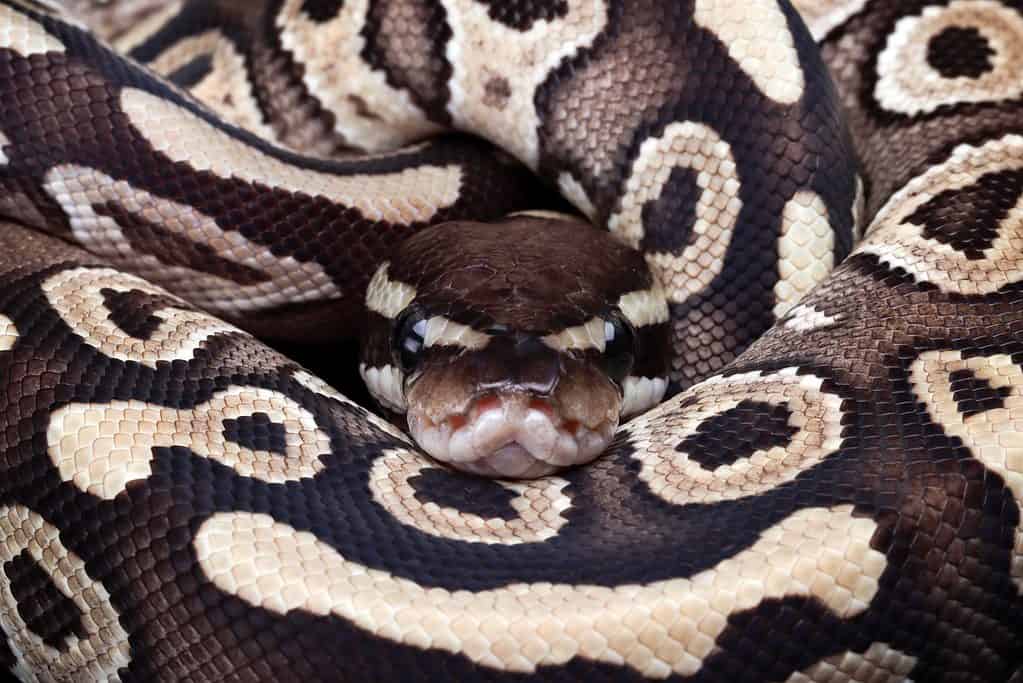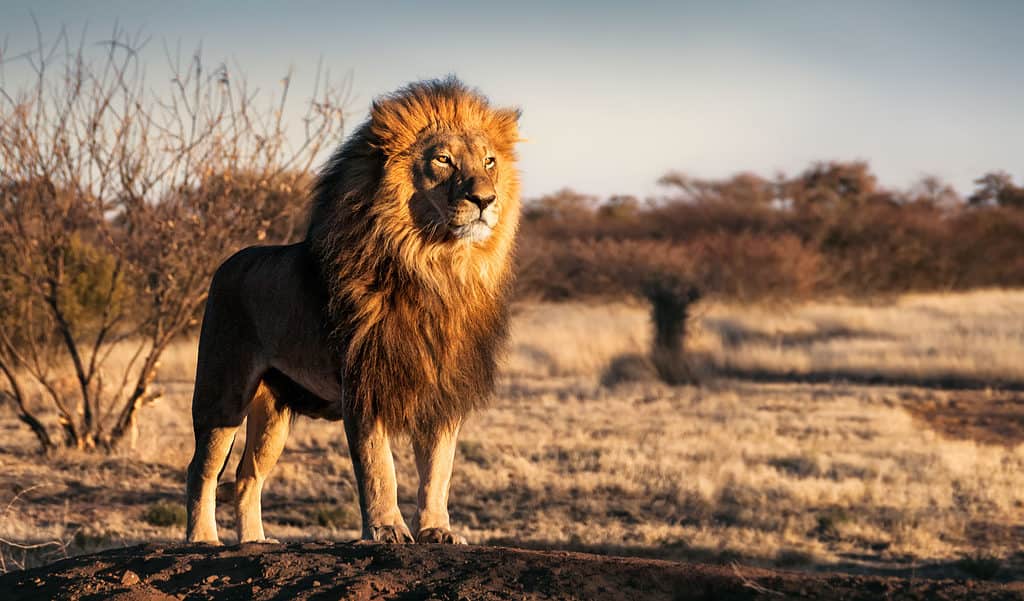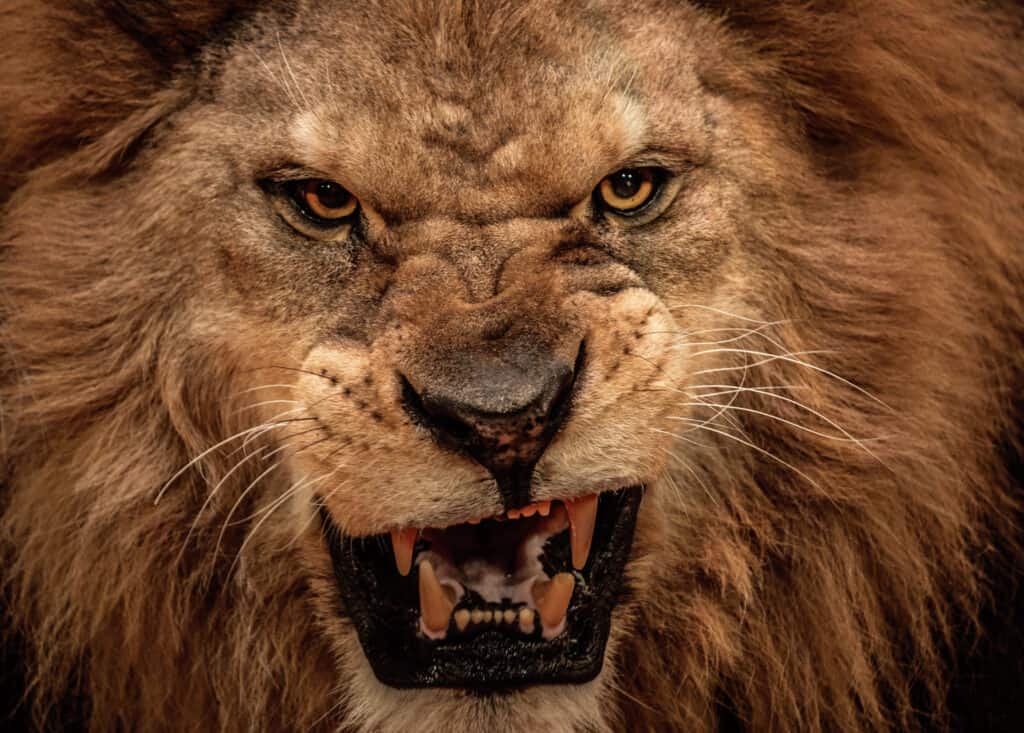Let the animal battle begin! It’s a python vs. lion fight; only one can be the champion.
Sometimes the deadliest predators are the ones you never see coming. That’s the case for the African rock python, the biggest snake in Africa. This slithery opponent can grow up to 30 feet long and uses its massive body to squeeze its prey to death. The bigger the python, the larger the prey. This is one of the only snakes with the guts to go after big impalas and win. But will they be victorious when they go head to head with a ferocious lion?
Follow along as we discover the strengths and weaknesses of each competitor and how they size up in the fighting ring. Who is going to walk away the victor? Will the win go to team lion? Or team python? Let’s find out in this ultimate animal match-up.
Python vs. Lion: Comparison Chart
| Battle factors | Python | Lion |
|---|---|---|
| Size | Females grow fastest 2 feet to 33 feet long 8 ounces to 250 pounds | Males are largest 3 to 4 feet tall 8 to 10 feet long 330 to 550 pounds |
| Speed | 4.9 mph | 50 mph over short distances |
| Characteristics | Non-venomous Suffocates prey Squishes prey with tightly coiled body Cuts off animals’ blood flow | Hunts with pride Ambush hunting techniques Trips prey Powerful roar Relies on members of the pride |
| Top advantages | Muscular body Stealth | Hunting strategies Strength Resilience |
What are the key factors in a python versus lion battle? This match-up will compare the competitor’s size, speed, attack abilities, and lifestyle. Being big and strong won’t be enough to win this fight. The champion will also need the best offensive and defensive fighting tactics and a few tricks to sway the odds. Let’s start by comparing each fighter’s size and speed.
The Python

A close-up shot of a Mojave ball python.
©Kurit afshen/Shutterstock.com
Slithering into the ring is competitor number one, the python. Pythons are ambush hunters who are most active at night.
These snakes use a specialized Jacobson’s organ to seek out prey with their tongue. Once they find a meal, pythons bite down, wrap their muscly scales around the body, and constrict until there isn’t any life left.
Pythons are one of the biggest snakes in the world and can weigh over 200 pounds. They get that big by eating a healthy diet of mammals, rodents, birds, and even jaguars!
How can one snake eat an entire jaguar? Loosening their tendons and ligaments, they open their jaw wide and swallow whole. Then the carcass begins dissolving in the snake’s acid-filled stomach.
The Lion

Lions have powerful paw swipes, razor-sharp claws, and a bite force of 1,000 PSI.
©2021 Photography/Shutterstock.com
Running into the ring at 50 mph, let’s welcome our feline competitor, the lion. Lions are also ambush predators who hunt under cover of darkness. They have powerful paw swipes, razor-sharp claws, and a bite force of 1,000 PSI. All of that force drives their 4-inch-long teeth deep into their victim’s throat.
As the second largest member of the cat family, lions can weigh over 500 pounds. Their large size and fierce tendencies send other animals running when they enter the scene. And where there’s one, there’s usually more.
Lions live in groups or pride, with anywhere from three to 40 members. These big cats are opportunistic hunters that will eat impalas, crocodiles, ostriches, and even crocodiles.
Round One: Size and Speed
Kicking things off with round one, let’s compare our competitor’s size and speed. The python is much longer than the lion. But can it slither away fast enough to claim a victory?
A Python can weigh an impressive 200 pounds and can grow as long as a car. Pythons can grow anywhere from 10 to 28 feet long! They’re one of Africa’s heaviest snakes, mostly made of muscle.
Pythons are comfortable moving on land and in water. These large muscular snakes can reach speeds of 2 to 3 mph in the water and 1 mph on land.
Lions weigh between 260 to 500 pounds. They can be up to 8 feet long and have an average shoulder height of 3 feet. At top speeds, these wildcats can go 50 mph in short bursts. They usually start around 35 mph and pick up speed as they get closer to the prey. Once their victim is within pouncing distance, these wild cats run as fast as possible!
Round Two: Attack Abilities

Pythons cause death by squeezing their prey.
©Heiko Kiera/Shutterstock.com
Round two compares the attack abilities of the python vs. the lion. Both of our competitors are carnivorous creatures; They kill to survive.
Pythons are one of the biggest and most powerful snakes in the world. Instead of relying on venom to take down their prey, these snakes use their body weight and strength.
The python’s tongue can pick up chemical traces of prey in the air. The rock python in Africa has up to eight heat-sensitive pits on their lips. These pits help them pinpoint prey with extreme accuracy. When they smell an animal they’d like to eat, the python waits patiently for the perfect chance to strike.
Pythons cause death by squeezing their prey. Their vice-like muscles can squeeze the life out of prey. Every time the prey exhales, they squeeze their coils even tighter, overwhelming the animal’s circulatory system. Some of their common prey include antelope, crocodiles, jackals, and even Impalas.
Lions can also take down large prey like antelope, and they, too, rely on the element of surprise. As experts of the Savannah, Lions know the perfect spots to hide from their unsuspecting victims. The lion will move as soon as their prey is within range.
Once it’s close enough to pounce, lions go for the animal’s throat or neck. They can drive their fangs so deep that they sever the prey’s spinal cord. Another technique these big cats use is slow strangulation. They bite down on the praise neck and hold, slowly suffocating their meal.
Round Three: Lifestyle

Lions are social creatures that live in a group called a pride.
©Nejron Photo/Shutterstock.com
The final round of our animal battle! Round three compares the lifestyle of the python vs. the lion.
Pythons are solitary creatures. They slither across the Savannah alone, waiting for their next victim to present themselves. These snakes can go months without food.
The larger the python, the larger the prey will take on. But sometimes bigger isn’t better. When a python makes a kill, it can take hours for them to swallow it. Their flexible ligaments and tendon muscles must open up enough for the prey to be devoured.
After opening wide, they use their powerful jaws and 90 razor-sharp teeth to pull the animal into their body. This process is time-consuming and opens the snake to a world of vulnerability. It’s common for other animals, like hyenas, to come across a snake digesting its meal and then steal it.
Lions are social creatures that live in a group called a pride. Living in a group gives lions the advantage of cooperative hunting and scavenging techniques. When they’re eating, they look out for each other. And when they’re hungry, they scavenge food for the group. These big cats will steal a fresh kill from an entire pack of hyenas!
Which Predator Is the Champion?
The lion is the winner! Pythons are powerful predators but no match for the mighty lion. If this snake were venomous, it’d only have to land one strike to win the fight. But pythons use a much slower death-by-squeeze tactic. This slithery opponent would have to launch the perfect sneak attack and hope the lion was alone.
Even if they could squeeze the life out of their feline foe, the python wouldn’t have enough time to finish their meal. It takes hours for these long snakes to swallow and digest a kill. After hearing the loud roars of the fight, other pride members would come to the lion’s aid. Once they saw the python was causing trouble, they’d quickly take out the threat.
The lion would still have the upper hand if this were strictly one-on-one. Lions are much faster than pythons, with a top speed of 50 miles per hour, compared to the snake’s measly 1 mph. Speed isn’t the python’s forte, making them no match for the fast and fierce lion.
The photo featured at the top of this post is ©
Thank you for reading! Have some feedback for us? Contact the AZ Animals editorial team.






